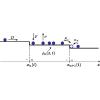当前位置:
X-MOL 学术
›
Phys. Rev. Lett.
›
论文详情
Our official English website, www.x-mol.net, welcomes your
feedback! (Note: you will need to create a separate account there.)
Stability of Vicinal Surfaces: Beyond the Quasistatic Approximation.
Physical Review Letters ( IF 8.1 ) Pub Date : 2020-01-24 , DOI: 10.1103/physrevlett.124.036101 L Guin 1, 2 , M E Jabbour 1, 3 , L Shaabani-Ardali 4, 5 , L Benoit-Maréchal 1, 2 , N Triantafyllidis 1, 3, 6
Physical Review Letters ( IF 8.1 ) Pub Date : 2020-01-24 , DOI: 10.1103/physrevlett.124.036101 L Guin 1, 2 , M E Jabbour 1, 3 , L Shaabani-Ardali 4, 5 , L Benoit-Maréchal 1, 2 , N Triantafyllidis 1, 3, 6
Affiliation

|
We revisit the step bunching instability without recourse to the quasistatic approximation and show that the stability diagrams are significantly altered, even in the low-deposition regime where it was thought sufficient. In particular, steps are unstable against bunching for attachment-detachment limited growth. By accounting for the dynamics and chemical effects, we can explain the onset of step bunching in Si(111)-(7×7) and GaAs(001) without resort to the inverse Schwoebel barrier or step-edge diffusion. Further, the size-scaling analysis of step-bunch growth, as induced by these two combined effects, agrees with the bunching regime observed at 750 °C in Si(111)-(7×7).
中文翻译:

相邻表面的稳定性:超出准静态近似。
我们在不求助于准静态逼近的情况下重新研究了台阶束的不稳定性,并表明,即使在认为足够的低沉积状态下,稳定性图也发生了显着变化。特别是,步骤对于聚集的附着-分离受限生长不稳定。通过考虑动力学和化学效应,我们可以解释在Si(111)-(7×7)和GaAs(001)中阶跃成束的发生,而无需借助反Schwoebel势垒或阶跃边缘扩散。此外,由这两种组合效应引起的阶梯状束增长的尺寸缩放分析与在Si(111)-(7×7)中在750°C下观察到的聚集态一致。
更新日期:2020-01-23
中文翻译:

相邻表面的稳定性:超出准静态近似。
我们在不求助于准静态逼近的情况下重新研究了台阶束的不稳定性,并表明,即使在认为足够的低沉积状态下,稳定性图也发生了显着变化。特别是,步骤对于聚集的附着-分离受限生长不稳定。通过考虑动力学和化学效应,我们可以解释在Si(111)-(7×7)和GaAs(001)中阶跃成束的发生,而无需借助反Schwoebel势垒或阶跃边缘扩散。此外,由这两种组合效应引起的阶梯状束增长的尺寸缩放分析与在Si(111)-(7×7)中在750°C下观察到的聚集态一致。











































 京公网安备 11010802027423号
京公网安备 11010802027423号